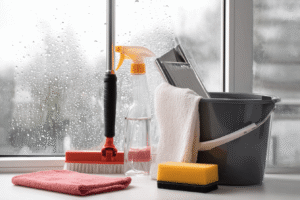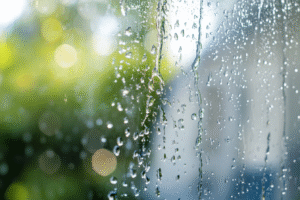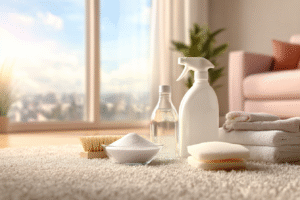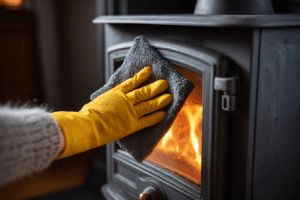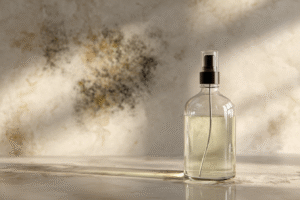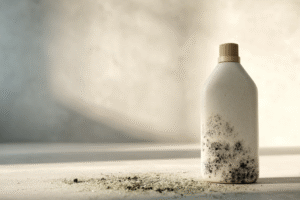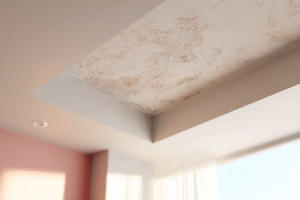Résumer cet article avec :
Feeling like you’re living in a horror movie with that creepy black mould lurking in your corners? You’re not alone! Black mould is a common household nightmare that thrives on condensation and can be dangerous to your health. But don’t panic—whether it’s spreading across your shower, walls, or windows, there are effective treatments to banish this unwelcome guest. Ready to declare war on those fuzzy black patches? Let’s dive into nine ways to kick mould to the curb and reclaim your space!

What exactly is black mould – and what treatment does it need?
We’ve all heard that black mould is bad for us, but what exactly is it? And how should we tackle it when it appears in our home?
Black mould, scientifically known as Stachybotrys chartarum, is a greenish-black fungus that thrives on materials with high cellulose content. It requires specific conditions to grow – primarily moisture from leaks, condensation or flooding, combined with humidity levels above 65%. Unlike other household moulds, it’s slow-growing but potentially more problematic, producing mycotoxins that can affect health.
| Building Material | Mould Growth Risk | Time to Develop |
|---|---|---|
| Wood | High | 1-2 weeks at 70%+ humidity |
| Plasterboard | Very High | 24-48 hours when damp |
| Tile Grout | Medium | 3-7 days in humid conditions |
Treatment options range from DIY solutions using fungicidal washes to professional remediation for extensive infestations. For any black mould treatment to be effective, you must first address the underlying moisture issue – otherwise, it will simply return. Like that annoying ex who just won’t take the hint!
Health effects & symptoms of black mould exposure
While most moulds aren’t harmful, black mould (Stachybotrys chartarum) produces mycotoxins that can trigger serious health issues in people. These toxic compounds can affect your respiratory system, nervous system, and overall wellbeing, particularly if you’re exposed for extended periods.
Black mould is known to cause a variety of health problems, ranging from mild allergic reactions to more severe conditions. Those most vulnerable include children, the elderly, and people with pre-existing respiratory conditions or weakened immune systems. In rare but extreme cases, prolonged exposure to high concentrations of black mould can contribute to life-threatening complications.
10 warning signs of mould toxicity
- Runny nose and nasal congestion
- Persistent coughing and sneezing
- Headaches or migraines
- Sore throat and difficulty breathing
- Eye irritation (red, itchy, or watery eyes)
- Skin rashes and itching (allergic reaction)
- Chronic fatigue and weakness
- Brain fog and memory problems
- Musty odour in your home
- Worsening of asthma symptoms or new onset asthma
If you notice these symptoms improving when you’re away from home but returning when you’re back, black mould could be the culprit. Don’t ignore these warning signs—they’re your body’s way of telling you something’s wrong!
9 Tips for getting rid of black mould
Safety gear: long rubber gloves & mask
Before starting the mould removal process, suit up properly! Inhaling mould spores can cause serious respiratory problems, so it’s important to take precautions. Grab your long rubber gloves (not just any gloves!) and a proper respiratory mask rated for mould removal. Keep a bucket with water nearby for rinsing your cleaning tools.
- Use specialised mildew removers. The 2025 market offers powerful mould and mildew removers like Clorox Tilex and CLR that kill 99.9% of household bacteria. Fill a spray bottle with your chosen solution for easy application.
- Scrub the area with a stiff brush. Attack those spores! Scrubbing the affected area will help to remove mould spores and prevent them from spreading. Be thorough but gentle on porous surfaces.
- Dry the area completely. Moisture is mould’s best friend. Once you’ve removed the mould, dry the area thoroughly to prevent it from returning. Use towels, fans, or a dehumidifier.
- Disinfect thoroughly. Choose your weapon wisely:
| Cleaning Agent | Effectiveness | Eco-Score |
|---|---|---|
| Bleach (1:10 with water) | Kills surface mould only | Low (toxic fumes) |
| White Vinegar | Kills 80% of mould species | High (natural acid) |
- Fix any water leaks. One of the main reasons black mould grows is because of moisture. If you have water leaks, fix them immediately and repair any water damage to prevent mould from returning.
- Improve your ventilation solution. Poor airflow creates mould paradise! Install extractor fans in bathrooms and kitchens, or consider a Positive Input Ventilation (PIV) system for persistent problems.
- Use a dehumidifier. Living in damp Britain? A dehumidifier is your new best mate! It reduces moisture in the air, making your home less hospitable for mould growth.
- Remove mouldy materials. Found mould growing on carpeting or drywall? Don’t be sentimental – these materials must go to prevent spores from spreading throughout your home.
- Clean regularly. Stay on top of it! Regular cleaning with soap and water helps remove mould spores before they take hold. Focus on damp-prone areas like bathrooms and kitchens.
With these tips, you’ll be saying “bye bye daily chores” to black mould and hello to a healthier home! Easy, peasy lemon squeezy!
Natural mould removers: vinegar, baking soda & more
Looking for a more eco-friendly way to tackle that pesky black mould? We’ve got you covered! Natural mould removers can be just as effective as chemical cleaners but without the harsh ingredients. Plus, you probably already have these items in your kitchen cupboard. Like Taylor Swift would say, “Look what you made me do” – except in this case, it’s making mould disappear!
Homemade mould cleaner recipe
Ready to whip up your own mould-fighting potion? This simple recipe will have you saying “Bye bye daily chores” in no time:
- Grab a clean spray bottle (never reuse one that contained other chemicals)
- Fill it with undiluted white vinegar
- Spray directly onto mouldy areas and let sit for 60 minutes
- For stubborn spots, make a baking soda solution (1 teaspoon baking soda + 2 cups water)
- Apply with a damp cloth to scrub away remaining mould
- Rinse with clean water and dry thoroughly
- Spray lightly with vinegar again to prevent regrowth
This works brilliantly for bathroom mould and even for your Washing Machine seal where mould loves to hide.
Baking soda mould hack
Baking soda isn’t just for baking – it’s a mould-fighting superhero in disguise! This treatment works wonders because baking soda absorbs moisture (which mould needs to thrive) while also acting as a gentle abrasive.
Simply mix baking soda with enough water to form a paste, apply to mouldy areas with a spray bottle or directly with a damp cloth, and let it sit for 15-20 minutes. Scrub gently, then rinse and dry thoroughly. For extra protection, consider using anti-mould paint afterward, which can remain effective for up to five years in high-humidity areas.
| Natural Cleaners | Chemical Cleaners |
|---|---|
| Eco-friendly & non-toxic | Faster acting on severe mould |
| Safe around children & pets | May contain harsh ingredients |
| Pleasant or neutral scent | Often strong chemical odour |
| Gentler on surfaces | Can damage certain materials |
| Affordable household items | Usually more expensive |
Easy, peasy lemon squeezy! These natural solutions give mould the boot while keeping your home free from harsh chemicals. What do you fancy trying first?
Black mould removal: step-by-step (shower, walls & windows)
If you think you may have black mould in your home, it’s important to act quickly. Mould can spread faster than a Taylor Swift album release, so let’s tackle it head-on! Follow these comprehensive steps to say “Bye bye daily chores” of mould removal:
- Safety first: Put on protective gear (gloves, mask, and goggles) before starting. Remember, we’re dealing with something that could affect your health, so no shortcuts here!
- Ventilate the area: Open windows to allow fresh air circulation. If working in a closed space like a bathroom, use an exhaust fan to keep the air moving. Good ventilation is your bestie during this process.
- Check for hidden mould inside walls: Look for warping, bubbling, or discoloration on walls which might indicate mould growing behind surfaces. Moisture meters or air quality monitors can help detect hidden mould spores that aren’t visible to the naked eye.
- Apply mould remover: Use a specific mould removal product in a spray bottle, like RMR-141 Disinfectant or Wet and Forget Mould Remover. For a DIY solution, mix one part bleach to 10 parts water (though commercial products are more effective).
- Dry thoroughly: After cleaning, ensure the area dries completely to prevent mould from returning. Maintaining proper humidity levels (30-50%) will help keep those pesky spores at bay.
How to get rid of black mould in shower
The shower is like mould’s favourite hangout spot. Here’s how to evict it:
| Tool | Action | Drying time |
|---|---|---|
| Stiff brush | Scrub grout lines and silicone seals | N/A |
| Mould spray | Apply to affected areas, leave for 15-30 minutes | 1-2 hours |
| Squeegee | Remove excess moisture after each shower | Immediate |
- Use a mould remover specifically designed for bathrooms. Apply generously to affected areas.
- Scrub the mouldy surfaces with a stiff brush, paying special attention to grout lines and silicone seals.
- Rinse thoroughly and dry with a clean towel.
- Increase ventilation by keeping the bathroom door open or using an exhaust fan. Open windows when possible to reduce humidity.
- Clean your bathroom regularly to prevent mould build-up, and use a squeegee after showers to reduce moisture.
How to get rid of black mould on walls
Finding mould on your walls is about as welcome as a surprise bill. Here’s how to handle it:
| Tool | Action | Drying time |
|---|---|---|
| Moisture meter | Detect damp areas within walls | N/A |
| Mould spray | Apply to affected surface, let sit 15 minutes | 2-4 hours |
| Anti-mould paint | Apply after treatment | 24 hours between coats |
- Ventilate the room by opening windows and doors to improve air circulation.
- Apply mould remover to affected areas and scrub with a stiff brush.
- After treatment, apply anti-mould paint which contains fungicides to prevent regrowth. These specialized paints create a protective barrier that resists moisture and inhibits mould growth.
- Consider installing a ventilation solution like a positive pressure unit or PIV (Positive Input Ventilation) system to maintain healthy air flow and reduce humidity levels.
- Check for and repair any leaks that might be causing moisture buildup inside walls.
Note: If black mould is noticeable on the outside of your walls, there is a very high chance that it has infiltrated your insulation. We recommend that you contact a professional to have the insulation removed and replaced.
How to get rid of black mould around windows
Window mould is like that uninvited guest who just won’t leave. Here’s how to show it the door:
| Tool | Action | Drying time |
|---|---|---|
| Soft cloth | Wipe condensation daily | Immediate |
| Mould spray | Apply to frames and seals | 1-2 hours |
| Dehumidifier | Reduce room humidity | Ongoing |
- Open windows regularly to reduce condensation and improve air circulation.
- Clean mouldy surfaces with a mould removal spray and scrub with a brush.
- Dry thoroughly and inspect window seals and caulking for cracks or gaps that might be letting moisture in.
- Use a dehumidifier to maintain optimal humidity levels (30-50%) in rooms prone to condensation.
- Clean your windows thoroughly at least once a week to prevent mould spores from settling and growing.
Note: If you notice black mould in your home, Wecasa recommends calling in a professional to assess the situation. Sometimes, black mould can be present in hidden areas, and attempting to clean it yourself could result in the spores spreading. A professional will be able to assess the situation and safely remove the mould without putting your family at risk. Easy, peasy lemon squeezy! You can also read our article on how to remove mould on windows.
Preventing black mould: simple rules
Feeling a bit meh about those pesky black spots on your walls? We’ve got your back! Preventing black mould is all about tackling moisture at its source before it becomes your unwanted flatmate. Here are our top tips to keep your home mould-free:
- Control condensation – Wipe down wet surfaces in bathrooms and kitchens after use. Keep kitchen and bathroom doors closed when showering or cooking to prevent moisture spreading.
- Improve ventilation solutions – Install extractor fans or consider a Positive Input Ventilation (PIV) system for persistent problems. Open windows regularly to create cross-ventilation (even in winter, just 10 minutes daily works wonders!).
- Check for rain leaks – Inspect window seals, roof tiles and guttering regularly. Fix any damaged seals or leaking pipes immediately as they’re perfect breeding grounds for mould.
- Maintain consistent heating – Keep your home at a steady temperature (around 18°C) rather than alternating between very hot and cold.
- Reduce indoor humidity – Use a dehumidifier in problem areas and consider anti-condensation or mould-resistant paint after treatment.
Note: If you notice black mould in your home, Wecasa recommends calling in a professional to assess the situation. Professional treatments are more effective than DIY solutions for serious mould problems, as they can identify hidden mould and address the underlying causes without risking further spread of harmful spores.
FAQ about cleaning black mould
Can I remove black mould myself?
+Yes, you can tackle small mould issues yourself, but safety first! Always wear protective gear (mask, gloves, goggles) to avoid inhaling spores. For areas larger than 1 square metre or if you have respiratory conditions, call a professional. What do you fancy: DIY or letting the pros handle it?
What is the best way to clean black mould?
+The best way is a combination approach: white vinegar kills 80% of mould species, while commercial mould removers contain fungicides for stubborn infestations. Always scrub the affected area, rinse thoroughly, and ensure complete drying. The key is addressing the moisture source – otherwise, your mouldy mate will return for an encore!
Can black mould be killed with bleach?
+Bleach works on non-porous surfaces but doesn’t penetrate porous materials like wood or drywall where mould roots hide. It’s a bit like putting a plaster on a broken arm – looks clean on the surface, but doesn’t solve the underlying problem. White vinegar or professional mould treatments are more effective for lasting results.
Is black mould harmful?
+Yes, black mould can be harmful, especially with prolonged exposure. It produces mycotoxins that may cause respiratory issues, headaches, skin irritation, and allergic reactions. Those with existing respiratory conditions, weakened immune systems, children and the elderly are particularly vulnerable. If you’re experiencing symptoms that improve when you leave your home, mould might be the culprit!
What kills mould permanently?
+Nothing kills mould permanently if moisture problems persist. The most effective approach combines: 1) Removing existing mould, 2) Fixing water leaks/condensation issues, 3) Improving ventilation, 4) Maintaining optimal humidity (30-50%), and 5) Using preventive treatments like anti-mould paint. Think of it like a breakup – you’ve got to change the environment to make sure they don’t come back!
Is it safe to clean black mould yourself?
+For small patches (under 1 square metre), DIY cleaning is usually safe if you wear protective gear and ensure good ventilation. However, if you have respiratory issues, are immunocompromised, or the mould covers large areas/is inside walls, it’s best to call professionals. They’ll be there for you, like they’ve been there before!
How do you clean mould with vinegar?
+Cleaning mould with vinegar is easy and eco-friendly! Fill a spray bottle with undiluted white vinegar, spray directly onto mouldy surfaces, and leave for one hour. Then scrub with a brush, rinse with warm water, and dry thoroughly. For stubborn areas, make a baking soda paste for extra scrubbing power. Vinegar’s acidity kills most mould species and helps prevent regrowth – bye bye daily chores!

 ChatGPT
ChatGPT
 Mistral
Mistral
 Claude
Claude
 Perplexity
Perplexity


